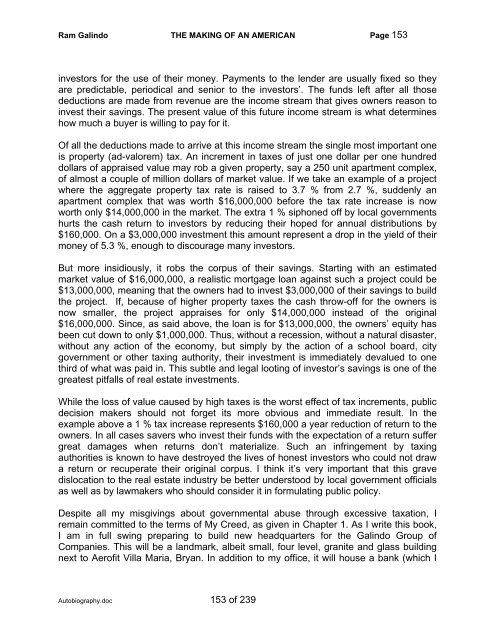Autobiography - The Galindo Group
Autobiography - The Galindo Group
Autobiography - The Galindo Group
Create successful ePaper yourself
Turn your PDF publications into a flip-book with our unique Google optimized e-Paper software.
Ram <strong>Galindo</strong> THE MAKING OF AN AMERICAN Page 153<br />
investors for the use of their money. Payments to the lender are usually fixed so they<br />
are predictable, periodical and senior to the investors’. <strong>The</strong> funds left after all those<br />
deductions are made from revenue are the income stream that gives owners reason to<br />
invest their savings. <strong>The</strong> present value of this future income stream is what determines<br />
how much a buyer is willing to pay for it.<br />
Of all the deductions made to arrive at this income stream the single most important one<br />
is property (ad-valorem) tax. An increment in taxes of just one dollar per one hundred<br />
dollars of appraised value may rob a given property, say a 250 unit apartment complex,<br />
of almost a couple of million dollars of market value. If we take an example of a project<br />
where the aggregate property tax rate is raised to 3.7 % from 2.7 %, suddenly an<br />
apartment complex that was worth $16,000,000 before the tax rate increase is now<br />
worth only $14,000,000 in the market. <strong>The</strong> extra 1 % siphoned off by local governments<br />
hurts the cash return to investors by reducing their hoped for annual distributions by<br />
$160,000. On a $3,000,000 investment this amount represent a drop in the yield of their<br />
money of 5.3 %, enough to discourage many investors.<br />
But more insidiously, it robs the corpus of their savings. Starting with an estimated<br />
market value of $16,000,000, a realistic mortgage loan against such a project could be<br />
$13,000,000, meaning that the owners had to invest $3,000,000 of their savings to build<br />
the project. If, because of higher property taxes the cash throw-off for the owners is<br />
now smaller, the project appraises for only $14,000,000 instead of the original<br />
$16,000,000. Since, as said above, the loan is for $13,000,000, the owners’ equity has<br />
been cut down to only $1,000,000. Thus, without a recession, without a natural disaster,<br />
without any action of the economy, but simply by the action of a school board, city<br />
government or other taxing authority, their investment is immediately devalued to one<br />
third of what was paid in. This subtle and legal looting of investor’s savings is one of the<br />
greatest pitfalls of real estate investments.<br />
While the loss of value caused by high taxes is the worst effect of tax increments, public<br />
decision makers should not forget its more obvious and immediate result. In the<br />
example above a 1 % tax increase represents $160,000 a year reduction of return to the<br />
owners. In all cases savers who invest their funds with the expectation of a return suffer<br />
great damages when returns don’t materialize. Such an infringement by taxing<br />
authorities is known to have destroyed the lives of honest investors who could not draw<br />
a return or recuperate their original corpus. I think it’s very important that this grave<br />
dislocation to the real estate industry be better understood by local government officials<br />
as well as by lawmakers who should consider it in formulating public policy.<br />
Despite all my misgivings about governmental abuse through excessive taxation, I<br />
remain committed to the terms of My Creed, as given in Chapter 1. As I write this book,<br />
I am in full swing preparing to build new headquarters for the <strong>Galindo</strong> <strong>Group</strong> of<br />
Companies. This will be a landmark, albeit small, four level, granite and glass building<br />
next to Aerofit Villa Maria, Bryan. In addition to my office, it will house a bank (which I<br />
<strong>Autobiography</strong>.doc 153 of 239


